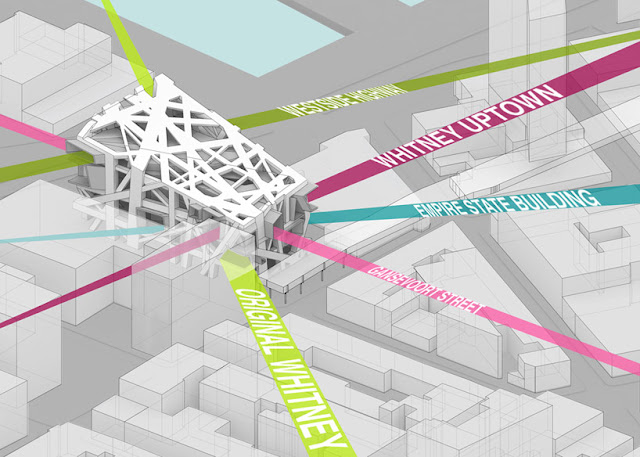Madison Avenue, New York City, United States
Axis Mundi
Post By:Kitticoon Poopong
 |
| Image © Courtesy of Axis Mundi |
New york architects
axis mundi have re-imagined the whitney downtown museum with a self-initiated proposal that is provocative, and as bold in spirit as the original breuer building on madison avenue.
 |
| Image © Courtesy of Axis Mundi |
 |
| Image © Courtesy of Axis Mundi |
With an intense sculptural presence, the axis mundi design represents an historical extension of the whitney’s commitment to innovative architecture, much as its polygonal windows and raw surfaces pay homage to the original breuer fenestration and its formal brutalism.
 |
| Image © Courtesy of Axis Mundi |
 |
| Image © Courtesy of Axis Mundi |
 |
| Image © Courtesy of Axis Mundi |
The site is located at the beginning of
the high line, at the intersection of washington and gansevoort streets.axis mundi sought to ground the newbuilding in a web of 'historical axes' which form and organize the program. the plan is based on a series of sight lines extending to 10th avenue, the
empire state building, the whitney on madison, and thelocation of the original whitney on
west 10th street.
 |
| site plan--drawing Courtesy of Axis Mundi |
 |
| site line--drawing Courtesy of Axis Mundi |
A desire for column-free galleries led the architects to create a perimeter superstructure to contain the staircases, escalators, elevators, and mechanical rooms. this structural lattice allows the galleries to float freely, suspended like bridges, unimpeded by a typical grid structure. the lattice allows light to flood the building in unexpected and dramatic ways, heightening the visitor’s perception of the artwork and the city
 |
| exploded axonometric diagram--drawing Courtesy of Axis Mundi |
 |
| axonometric section--drawing Courtesy of Axis Mundi |
Maintaining vitality at street level and reducing the distance between the street and the art itself was an important consideration for the designers at axis mundi. instead of designing a large vacant lobby,an informal intermingling of public and private space occurs on the street level plinth, creating a complex folding of the urban fabric. the plinth is populated by large-scale sculptures, an outdoor cafe bridge, an info kiosk, and a performance area. a continuous path, weaving in and out of the lattice structure,leads the visitor from the entrance ramp at the corner of washington and gansevoort up to the panoramic viewing deck, overlooking the hudson river and the high line.
John beckmann, principal of axis mundi stated 'we imagine the contemporary museum to be a dynamic environment - a space that is less a container and more of a conduit.'
 |
| floor plans--drawing Courtesy of Axis Mundi |
 |
| floor plans--drawing Courtesy of Axis Mundi |
 |
| floor plans--drawing Courtesy of Axis Mundi |
The people
Architects: Axis Mundi
Location: Madison Avenue, New York City, United States
Design Team: John Beckmann, Andy Vann, Denise Pereira and Marielle Vargas
Renderings: Viviane Liao and Andy Vann
Illustrations + Diagrams: Denise Pereira and Andy Vann
Height: varies from 75 ft to 175 ft
Floors: 6 above (2 below)
Building Footprint: 39,000 square feet
Usable Square Footage: 195,000 square feet
Images: © Courtesy of Axis Mundi












